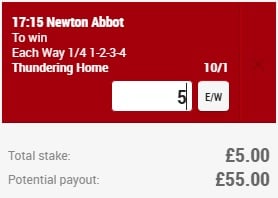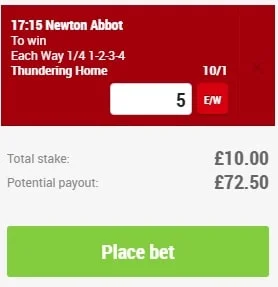
England Women vs Wales Women Prediction Betting Tips & Preview
Date: 13/07/25Kick-off time: 20:00Venue: KybunparkThe final group game of UEFA Women’s Euro 2025 sees England Women take on Wales Women at Kybunpark, St. Gallen, on…
Here at Which Bookie, our aim is to make online gambling simple, fun and profitable for everyone. That’s why we provide a range of guides and tutorials for beginners all the way to experienced punters. Today, we’re going to look at each way betting.
So what does each way betting mean? What sports can you use them on? How do they work, how much do you have to stake, and what are the returns? We’ll explain everything, using some real life examples. So grab a coffee, make yourself comfortable, and let’s get started…
Which Bookie horse racing analyst Will Smith has prepared the video shown below in which he explains the each way bet meaning and how each way bets work, when they win & lose, how they’re settled and how to make the most of each way bets using extra places.
Before we get started with this article, you may want to take a look at our horse racing live streaming page which contains links to all UK & Irish horse races which you can watch live.
 | Read Review | Visit |
 | Read Review | Visit |
 | Read Review | Visit |
 | Read Review | Visit |
 | Read Review | Visit |
 | Read Review | Visit |
An each way bet is traditionally used in horse racing, but it can also be used in greyhound racing, football, golf or tennis. For example, you could place an Each Way bet on England to win the 2022 World Cup. In this case, your bet would win if England finished in the top 4 or however many places the bookie was offering. We’ll look at how it works with these sports in more detail later.
Traditionally, you would place this type of wager when backing an outsider at longer odds. You think it has a good chance of winning, but obviously the odds suggest there are other outcomes that are more fancied by the market.
If you simply backed your selection “outright” then you would only get a return on your stake if it wins. But by choosing each way, you’d also get a potentially profitable return even if it only placed. By placed, we mean finished second, third or even fourth (depending on the terms of the race with the bookmaker).
When you bet each way, your total stake is split into two equal parts and you are actually placing two separate wagers in one bet. This happens automatically when you tick “E/W” on your betslip. One half of your stake is used to back your selection to win. The other half is used to back your selection to place.
If your selection wins, then both of these individual wagers win, meaning you get the maximum possible return. If your selection places, then the win part of your stake loses, but the place part wins. Depending on the odds, this means that you can potentially still make a decent profit even if your selection isn’t actually the winner.
So you now know what the term means, but how do you actually place an each way bet? Well, it’s not actually that difficult.
Here’s an Each Way Bet explained…
Let’s look at an example. In this case, we’re looking at a horse race at 32Red Sport, as they usually have pretty good each way terms. However, the process would be very similar at any of the other top online bookies.
 We’ve picked a race at Newton Abbot and decided to back a horse called Thundering Home. In this case, there’s no particular reason for choosing this horse other than the fact that, with a name like that, we’re expecting it to win!
We’ve picked a race at Newton Abbot and decided to back a horse called Thundering Home. In this case, there’s no particular reason for choosing this horse other than the fact that, with a name like that, we’re expecting it to win!
As usual, you just need to click on the selection to add it to the betslip, and then enter your stake. This shows that the odds on the horse to win are 10/1 and that a £5 stake would return £55.
 However, in this case we don’t just want to back it to win. We’re not completely certain the horse will win, so we want to back it each way just in case another horse finishes stronger. So to do this you would just need to click the E/W button on the betslip. When you do that, you’ll notice that the total stake has changed to £10, because remember that we are actually making two separate wagers, each of equal value with £5 of our bet being placed on our horse to win and £5 on our horse to finish in a place position.
However, in this case we don’t just want to back it to win. We’re not completely certain the horse will win, so we want to back it each way just in case another horse finishes stronger. So to do this you would just need to click the E/W button on the betslip. When you do that, you’ll notice that the total stake has changed to £10, because remember that we are actually making two separate wagers, each of equal value with £5 of our bet being placed on our horse to win and £5 on our horse to finish in a place position.
The potential payout has also changed, but this hasn’t doubled like the stake has. In fact it only increased from £55 to £72.50. Now let’s take a look at how they work this out.
So now you know how they work, but how do you calculate the returns on an each way bet? Let’s return to the example above and break it down.
Remember that we have £5 on Thundering Home to win, and £5 on it to place. The win part of the wager is always paid out as normal. As you saw in the first betslip, the £5 win part of the stake at 10/1 would return £55.
 The return on the place bet depends on the bookie’s place terms for this race. These can vary quite a lot, depending on how many horses are in the race, and also depending on the bookie themselves. Some bookies pay extra places on certain events, which gives you a better chance of winning. Todays Extra Place Races are always listed on this site here.
The return on the place bet depends on the bookie’s place terms for this race. These can vary quite a lot, depending on how many horses are in the race, and also depending on the bookie themselves. Some bookies pay extra places on certain events, which gives you a better chance of winning. Todays Extra Place Races are always listed on this site here.
The place terms are always displayed on the betslip. Look again at the above example and you can see that it says:
Each Way 1/4 1-2-3-4
That means that the bookie is paying 1/4 odds if the horse finishes anywhere in the first 4 places. The win odds are 10/1 so the place odds would be 1/4 of that, which is 2.5/1 (or 5/2 as it would normally be displayed). Therefore the place bet of £5 at 5/2 would return £17.50.
Overall then, if Thundering Home lives up to his name and wins, then both parts of the each way bet will win. The return would be £55 + £17.50 = £72.50.
If he finishes 2nd, 3rd or 4th then only the place part of the wager would win, which means the £10 stake would return £17.50. So we’d still make a profit even if we didn’t quite call the race correctly.
As mentioned above, each way bets are most commonly associated with horse racing. As there are usually several outcomes of a horse race given that there are multiple runners, each way bets can increase your chances of a return as your bet will pay out if your horse finishes in a place position and not just if it wins the race.
WhichBookie racing analysts often take advantage of Extra Places in their Each Way tips which result in a greater return in the long term for followers.
Bookmakers will state the place terms on every race that they’re taking bets on. The place terms may vary depending on whether or not they are offering extra places but there are standard industry place terms that you can use as a basis guide.
| Race Type / No. of Runners | Places | Odds |
|---|---|---|
| 1-4 Runners | 1 | - |
| 5-7 Runners | 2 | 1/4 |
| 8+ Runners (Non-Handicap) | 3 | 1/5 |
| 12-15 Runners (Handicap) | 3 | 1/4 |
| 16+ Runners (Handicap) | 4 | 1/4 |
In short:
Any races in which there are 1-4 runners will only pay out on the winner. Each way bets will not be taken on these races.
Each way bets on races in which there are 5, 6 or 7 runners will pay out on the first two places with the place part of the bet being paid out at 1/4 of the odds.
If a race as 8, 9, 10 or 11 runners, each way bets are paid out on the first three places with the place part of the bet settled at 1/4 of the odds.
If the race is a handicap, each ways bets are paid out on the first three places if there are 12, 13, 14 or 15 runners at 1/4 of the odds and on the first four places at 1/5 of the odds if there are 16 or more runners.
For major racing events such as the Grand National, bookies often offer several additional places. You’ll also find Extra Places available daily from bookmakers such as Betfred, Bet365, William Hill, Coral, Ladbrokes and Betfair. WhichBookie also provides free Cheltenham EW tips for the upcoming festival races.
We’ve already looked at horse racing in detail, and greyhound racing works in exactly the same way. It’s pretty obvious when you’re picking the winner of a race, but what about other sports?
Outright tournament markets often present an ideal opportunity for using each way bets. You can place an each way wager on the winner of a golf tournament and for many tournaments bookmakers will pay up to 6 places for the place part of your bet. In the major golf tournaments eg US Masters or The Open some bookmakers will pay as many as 10 places. Therefore, you’d still get a return if your player finishes in the top 10 places on the final leaderboard.
Considering how hard it is to actually pick the winner in the outright market, this is an option that a lot of smart punters use. The odds in this market are usually huge, so you almost always get a great return even if your player just places.
Each way betting on football tends to be on individual League or Tournament outright betting. Place terms will vary depending on the bookmaker and the Competition . Place terms will also vary depending on what stage the League or Competition is at eg Prior to the start of a Premier League season , bookies will generally offer each way betting of either 1/4 odds 1,2,3 or 1/4 odds 1,2 . However once the League is under way and the number of teams challenging reduces the each way terms are likely to reduce. For most knock out tournaments eg FA Cup or Champions League the standard each way terms tends to be 1/2 odds 1,2 ie 1st or 2nd
Similar to football , each way betting on tennis is generally on Tournament outright betting. Prior to the start of a tennis tournament , place terms will generally be 1/2 odds 1,2 . In effect the place part of an each way outright tennis bet is for the player to reach the Final.
By placing an each way bet over a standard win bet, you increase the chances of your bet winning. As explained earlier, with a win bet, your bet will only win if your selection wins. However, with an each way bet, some of your bet will win if your selection finishes in a place position also. If there is a strong favourite in a race or tournament then you may wish to place an each way bet on a strong contender but who you think may not be extremely likely to win. This way, there is a good chance the place part of your bet will come in and it will be an added bonus should they end up winning.
Overall, each way bets are considered lower-risk than standard win bet.
Although the risk of receiving no return is lowered with each way bets, you are risking more money due to your stake being doubled. For example, a losing £5 win bet would cost you £5 but a losing each way bet would cost you £10 as you will have placed £5 on the win and £5 on a place finish.
Another disadvantage of an each way bet is that should your selection win, you will receive less returns than if you placed the same total stake on just the win. This is to compensate for the additional security you have of receiving a return should your selection finish in a place position. Also, you are not always guaranteed a profit should your selection finish in a place position and your returns are dependent on the odds of your selection. For example, if you placed a £5 each way bet (£10 total stake) on a horse at odds of 4/1 with place odds of 1/4, your returns would be:
As you can see, if your horse places, you will only break even at the odds used in the example. Therefore, many prefer to place each way bets on selections with higher odds which they believe have a chance of finishing in a top position so that they return a profit if their selection wins or places.
As well as placing a single each way bet, you can also place an accumulator consisting of each way selections. Similar to single each way bets, when you do this, you are placing two bets.
For you to receive any return from your win accumulator, all your selections must win. If you placed a 5-fold each way accumulator and four won and one placed, this part of your bet would lose. You can therefore understand that these bets are generally quite difficult to win. However, to compensate, they will, therefore generally have very high odds which can return high profits should they do so.
For you to receive any return from your place accumulator, all your selections must either place or win. It is important to remember that if one or more of your selections in your place accumulator win, the odds for those selections will be the place odds and not the win odds.
For example, if your selections in your 5-fold place accumulator finished as below and the place odds were 1/4, the odds for each selection contributing to the overall odds of your ACCA would be:
Therefore, the total odds for your place accumulator, regardless of whether your selections won or placed would be 1/1 x 1/1 x 1/1 x 1/1 x 1/1 = 31/1 (32.0)
A less commonly used each way bet type are ‘Equally Divided Bets, also known as ‘All Each Way’ bets. With these bets, instead of having a win accumulator and a place accumulator, your returns from your first bet are split equally between the win and place part for your next bet.
Using the 5-fold example above with the same finishing positions and a £1 All Each Way stake, our returns would be:
We are using quite low odds in the example above and so if the odds for the selections were higher, a much greater profit could be achieved. Similarly, the more winners which come in, the greater the returns.
Did We Answer Your Question?
We hope that you have found this tutorial useful. If you did, please consider linking to us from your own blog or website, or sharing this page with your friends and followers. If you have any suggestions of how we can improve this guide, or if there’s any other subject you’d like us to cover, please let us know. We’d be glad to hear your feedback.
 | Read Review | Visit |
 | Read Review | Visit |
 | Read Review | Visit |
 | Read Review | Visit |
 | Read Review | Visit |
 | Read Review | Visit |
